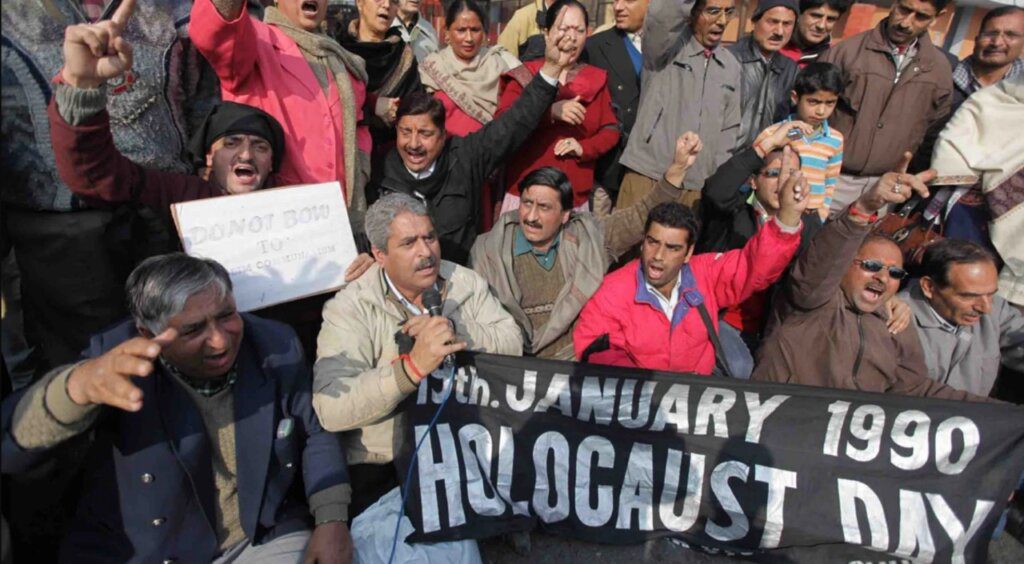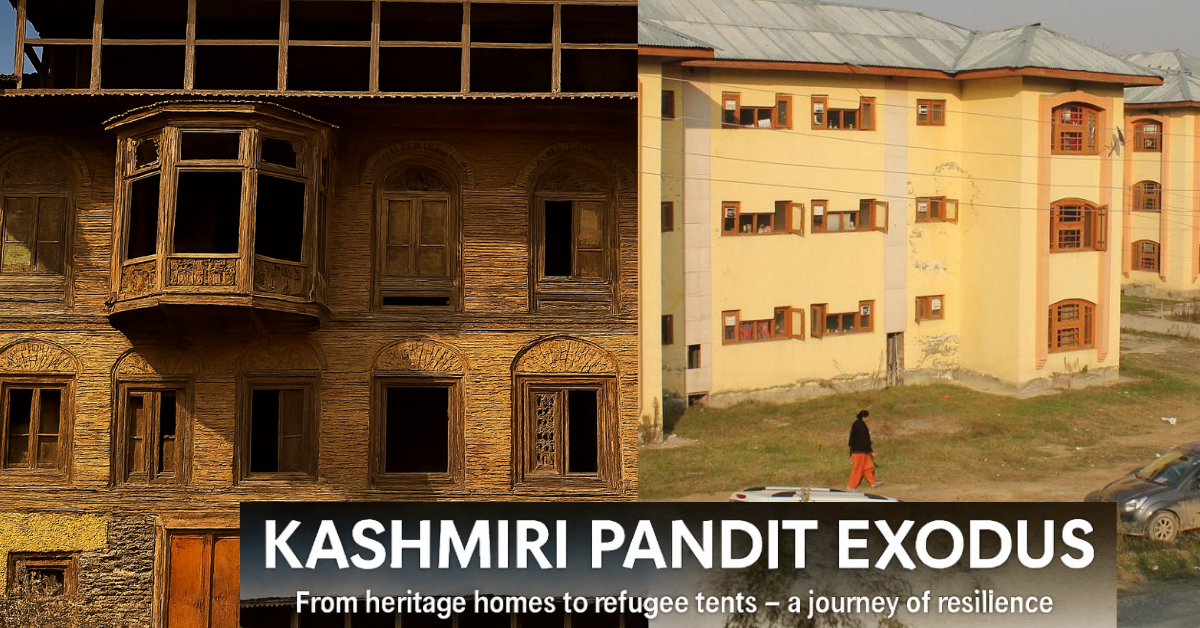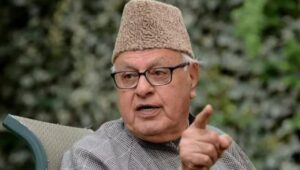I was in my first year of college when the Genocide of Kashmiri Pandits happened, causing internal displacement of Kashmiri Pandits. We didn’t know it would be forever. I still remember the whispers in the dark, the hurried packing, and the fear that hollowed out our home.
We didn’t move by choice. We were forced to flee.
And today, when I hear someone say, “It never happened,” The Kashmir Files was Propaganda,” it feels like being murdered twice. Consequently, this article exposes the uncomfortable truth about how hate speech became the genocide of Kashmiri Pandits.
This year marks 35 years of the Kashmiri Pandit exodus, a day remembered not just for what was lost, but what was never recovered.
The Delhi High Court’s Warning: Hate Speech and Demographic Shifts
In a significant observation by the Delhi High Court, Justice Chandra Dhari Singh noted that hate speeches have historically triggered demographic shifts, citing the exodus of Kashmiri Pandits as a prime example.
On June 13, 2022, the Delhi High Court made a groundbreaking observation. Justice Chandra Dhari Singh connected dots that politicians deliberately ignore. Furthermore, his statement exposed the direct link between hate speech and ethnic cleansing.
“Hate speeches are the beginning point of attacks against targeted communities,” Justice Singh declared. “There have been instances of demographic shifts after inflammatory speeches. The exodus of Kashmiri Pandits exemplifies this pattern.”
This wasn’t merely a legal observation. Instead, it was judicial recognition of the genocide of Kashmiri Pandits. Moreover, it validated what survivors have been saying for decades.
Three years later, that observation feels more urgent than ever.
This article explores how hate speech isn’t just rhetoric. It’s a weapon. A weapon against humanity. A weapon against religious minorities.
Genocide of Kashmiri Pandits
The genocide of Kashmiri Pandits didn’t happen overnight. Instead, it followed a calculated pattern that those extremists and politicians had perfected. Additionally, understanding this systematic approach helps us recognise similar threats today.
Stage One: Dehumanising Kashmir’s Hindu Population
First, the genocide of Kashmiri Pandits began with dehumanising language. Separatist leaders and religious extremists started using inflammatory terms. Furthermore, they labelled the entire Pandit community as “Indian spies” and “kafirs.”
This language prepared Kashmiri society for violence against Hindus. Moreover, it portrayed Pandits as enemies rather than neighbours. Additionally, mosques amplified these messages through loudspeakers daily.
Stage Two: Manufacturing Fear Against Hindu Families
Next, the genocide of Kashmiri Pandits thrived on manufactured conspiracy theories. Leaders spread false stories about Hindu dominance and oppression. Additionally, they claimed Pandits were plotting against Kashmir’s Muslim identity.
The pattern became systematic across the valley. Furthermore, fear became the fuel that ignited mob violence. Consequently, rational discourse between communities became impossible.
Stage Three: Systematic Violence and Forced Displacement
Finally, the genocide of Kashmiri Pandits culminated in systematic violence. Hindu families faced targeted killings and brutal assaults. Moreover, sexual violence against women became normalised and justified. Therefore, displacement became the only option for survival.
1990: When Kashmir Lost Its Soul Forever
The numbers tell a story that propaganda cannot erase. In 1990, Kashmiri Pandits comprised nearly 5% of Kashmir’s population. However, the genocide of Kashmiri Pandits reduced that number to almost zero by 2025.
This demographic catastrophe didn’t occur naturally. Instead, it was produced through systematic ethnic cleansing. Furthermore, political leaders from all parties played their roles in enabling this tragedy.
Slogans That Became Death Sentences
The streets of Srinagar echoed with chants that became death sentences for Hindus. Moreover, these weren’t random outbursts of anger. Instead, they were coordinated campaigns that facilitated the genocide of Kashmiri Pandits.
“Kashmir banega Pakistan” (Kashmir will become Pakistan) wasn’t just a slogan. Similarly, “Asi gachchi Pakistan, Batao roas te Batanev san” ( We want Pakistan with Kashmiri Pandit women, without their men) carried a chilling message about Hindu women. Additionally, these chants explicitly threatened the entire Pandit community with death.
Yehan Kya Chalega, Nizame Mustafa
The systematic nature of these campaigns proved that the genocide of Kashmiri Pandits was premeditated.

Political Complicity: How Parties Enabled Genocide Of Kashmiri Pandits
Congress Party: Appeasement That Enabled Genocide
The Congress party’s role in enabling the genocide of Kashmiri Pandits cannot be ignored. Furthermore, their desperate attempt to maintain power in Kashmir led to fatal compromises. Additionally, they rigged the 1987 elections so blatantly that they radicalised Kashmiri youth.
When democracy died in broad daylight, militancy found fertile ground. Moreover, Congress leaders chose political survival over protecting Hindu lives. Consequently, their appeasement policies directly contributed to the genocide of Kashmiri Pandits.
Mufti Mohammad Sayeed: The Fatal Decision That Changed Everything
December 8, 1989, changed Kashmir forever for Hindu families. When militants kidnapped Rubaiya Sayeed, her father made a decision that enabled the genocide of Kashmiri Pandits. Furthermore, Home Minister Mufti Mohammad Sayeed chose to negotiate with terrorists.
Five hardcore terrorists were released for one person. Additionally, this precedent sent a clear message to militants across Kashmir. Moreover, they realised they could target Hindus without facing consequences.
Within days, these freed terrorists paraded through Srinagar’s streets. Furthermore, they declared ownership of the city. Consequently, the genocide of Kashmiri Pandits gained momentum from this governmental weakness.
BJP: The Silent Spectators During Our Holocaust
On December 8, 1989, militants kidnapped Mufti Mohammad Sayeed’s daughter, Rubaiya Sayeed. The government gave in to the pressure and released five terrorists, marking a turning point in Kashmir’s descent into lawlessness. The kidnapping of Rubaiya Sayeed wasn’t just a personal tragedy. It signalled to extremists that the state could be coerced, and Hindus could be targeted without consequence.
The BJP continued supporting the VP Singh government even after the VP Singh Govt released five dreaded terrorists in exchange for Rubaiyya Sayeed.
Furthermore, they kept supporting the VP Singh government while Kashmiri Pandits were being systematically slaughtered. Their silence during this critical period enabled the ethnic cleansing that followed.
Where were the protests when the genocide of Kashmiri Pandits was unfolding? Where was the national outrage that the BJP claims to represent today? Where were the dharnas and bandhs that they organised for far lesser issues?
The answer remains painfully clear: they prioritised bringing down Congress over preventing genocide. They withdrew support only after LK Advani’s arrest.
The Numbers Don’t Lie:
- December 1989: Terrorist release with BJP’s tacit approval
- January-December 1990: Hundreds of Kashmiri Pandits were Killed in 1990
- BJP’s response: BJP remains silent.
They were more interested in political calculations than in protecting Hindu lives. When it mattered most. When an entire Kashmiri Pandit community was being ethnically cleansed, they were silent spectators to genocide.
National Conference: Local Enablers of Hindu Persecution
Farooq Abdullah’s National Conference created the perfect storm for the genocide of Kashmiri Pandits. Furthermore, their rigged elections and minority appeasement policies destroyed Kashmir’s secular fabric. Additionally, they abdicated their responsibility to protect Hindu families.
They didn’t pull triggers, but they loaded the guns. Moreover, their actions created an environment where anti-Hindu hatred could flourish unchecked. Consequently, every subsequent killing bore its political fingerprints.
The Brutal Reality: How Systematic Murder Unfolded
Between 1990 and 1991, the genocide of Kashmiri Pandits claimed hundreds of innocent lives. Furthermore, each killing was more brutal than the last. Additionally, the message was crystal clear: no Hindu was safe in Kashmir.
The systematic nature of violence proved this was genocide, not random communal riots:
Girija Tickoo – A school librarian who was kidnapped, gang-raped and brutally murdered. Moreover, her killing sent shockwaves through the entire Pandit community. Additionally, it demonstrated that the genocide of Kashmiri Pandits specifically targeted women with sexual violence.
Sarvanand Kaul Premi – A renowned poet who was killed along with his younger son, Veriender Kaul. Furthermore, their murders symbolised the death of Kashmir’s composite culture. Additionally, it showed that intellectuals and their families were being systematically eliminated during the genocide of Kashmiri Pandits.
Lassa Kaul – The Director of Doordarshan Kendra Srinagar, who was brutally murdered for his professional work. Moreover, his killing proved that media professionals were specifically targeted. Additionally, his murder demonstrated how the genocide of Kashmiri Pandits aimed to silence Hindu voices in public discourse.
Tika Lal Taploo – A prominent advocate and BJP leader who was shot dead in broad daylight. Furthermore, his assassination marked the beginning of targeted killings. Additionally, it demonstrated that the genocide of Kashmiri Pandits had specific hit lists.
These weren’t random acts of violence. Instead, they were calculated moves in the systematic genocide of Kashmiri Pandits. Furthermore, each killing was designed to terrorise and displace the entire Hindu community.
The Refugee Crisis: Life After Genocide
The survivors of the genocide of Kashmiri Pandits became refugees in their own country. Furthermore, Kashmiri Pandits faced decades of neglect and systematic discrimination. Additionally, multiple generations have grown up in exile without government support.
Living Conditions in Refugee Camps
The aftermath of the genocide of Kashmiri Pandits created a humanitarian crisis:
- Families lived in tents for decades in Mishriwala, Purkhoo, Muthi, Jhiri, and Battal Ballian
- Children grew up without proper educational facilities
- Medical care remained inadequate in overcrowded camps
- Employment opportunities were limited due to displacement
- Cultural practices slowly disappeared due to urban living
Moreover, these conditions perpetuated the trauma of ethnic cleansing. Additionally, the government’s indifference compounded the suffering of genocide survivors.
The Role of Media: Silence During Our Darkest Hour
The genocide of Kashmiri Pandits occurred with minimal media coverage. Furthermore, national newspapers largely ignored systematic persecution. Additionally, electronic media failed to highlight the gravity of ethnic cleansing.
Press Coverage: The Conspiracy of Silence
During the genocide of Kashmiri Pandits, the media response was shockingly inadequate:
- Major newspapers buried stories about Hindu persecution
- Television channels focused on militancy rather than genocide
- Editorial positions often blamed the victims for their suffering
- International media ignored the ethnic cleansing completely
- Journalists feared reporting the truth about systematic violence
Government Response: Betrayal and Neglect
The Indian government’s response to the genocide of Kashmiri Pandits remains shamefully inadequate. Furthermore, successive administrations have failed to provide justice or adequate rehabilitation. Additionally, political parties continue using this tragedy for electoral gains.
Policy Failures and Broken Promises
Government policies regarding the genocide of Kashmiri Pandits have consistently failed:
- Rehabilitation packages remained inadequate for dignified resettlement
- Employment schemes provided limited opportunities for survivors
- Housing projects were delayed or remained incomplete for decades
Justice Denied: No Accountability for Perpetrators
The genocide of Kashmiri Pandits has seen zero convictions for systematic killing:
- No terrorist has been convicted of murdering Hindu civilians
- Political leaders who enabled genocide faced no consequences
- Police officers who remained silent were never prosecuted
- Government officials who failed in their duty got promotions instead
- Truth and reconciliation processes were never established officially
Furthermore, this lack of accountability encourages future genocides. Additionally, it sends a message that minority persecution carries no consequences.
Conclusion:
The genocide of Kashmiri Pandits represents one of modern India’s greatest tragedies. Furthermore, it demonstrates how quickly civilisations can be destroyed. Additionally, it warns us about the fragility of secular democracy.
We cannot bring back the lives lost to systematic persecution. However, we can ensure that future generations learn from this tragedy. Moreover, we can build a society where such genocide becomes impossible.
The survivors of the genocide of Kashmiri Pandits deserve justice, not just sympathy. Furthermore, they deserve acknowledgement, not just assistance. Additionally, they deserve a homeland where they can live with dignity and security.
Frequently Asked Questions (FAQs) About the Genocide of Kashmiri Pandits
What is the Kashmiri Pandit genocide?
The Kashmiri Pandit genocide refers to the systematic ethnic cleansing and forced displacement of the Hindu minority community from the Kashmir Valley from 1989 to 1990. Thousands were killed, women were raped, and nearly the entire population of Pandits, around 400,000, was forced into exile.
When did the exodus of Kashmiri Pandits happen?
The mass exodus began in January 1990, following months of escalating threats, hate speeches, and killings. The violence peaked in the early months of 1990, forcing almost the entire community to flee within weeks.
What caused the Kashmiri Pandit genocide?
The genocide was triggered by organised hate speech, religious extremism, and political instability. Militant slogans from mosques and public rallies openly called for Hindus to leave, convert, or die. The state’s failure to protect minorities made the genocide inevitable.
How many Kashmiri Pandits were killed during the genocide?
Although exact numbers vary, hundreds of Kashmiri Pandits were murdered between 1989 and 1991. Victims included intellectuals, government officials, and women, often killed brutally to instil fear and drive mass displacement.
Were women targeted explicitly during the genocide?
Yes. Women were subjected to sexual violence as a tool of ethnic terror. One harrowing example is Girija Tickoo, a school librarian who was gang-raped and brutally murdered. These crimes went largely unpunished and were meant to terrorise the entire community.
Was the genocide of Kashmiri Pandits officially recognised?
While not officially termed “genocide” by the Indian government, the Delhi High Court in 2022 acknowledged that hate speech led to demographic shifts, referring to the Pandit exodus as a direct consequence of inflammatory rhetoric and violence.
Which political parties were responsible or complicit in the genocide?
Multiple political parties were either complicit or failed to act:
- Congress: Rigged the 1987 elections, which fueled militancy.
- National Conference: Enabled radicalisation and neglected Hindu protection.
- BJP: Remained silent while supporting the VP Singh government, which released terrorists in exchange for Mufti Mohammad Sayeed’s daughter.
What slogans were used against Kashmiri Pandits during the genocide?
Militant slogans included:
- “Kashmir banega Pakistan” (“Kashmir will become Pakistan”)
- “Asi gachchi Pakistan, Batao roas te Batanev san” (We want Pakistan, without Pandit men and with their women)
These were not just threats; they were calls to action that instigated mass violence.
What role did the media play during the genocide?
Mainstream Indian and international media largely ignored the genocide. Coverage was minimal, biased, or outright dismissive. There was no consistent national outrage or investigative reporting during the most brutal phase of the violence.
Has justice been served for the Kashmiri Pandit genocide?
No. More than three decades later, there have been no major convictions of those responsible. Political leaders, militants, and even law enforcement officers involved have faced zero accountability. Justice remains elusive.
Why do some people deny the Kashmiri Pandit genocide?
Some political groups and ideologues downplay or outright deny the genocide to serve narratives of victimhood or resistance. This denial is deeply painful for survivors and amounts to a second injustice after their trauma.
What was the impact of the 1989 Rubaiya Sayeed kidnapping on the genocide?
The kidnapping of Rubaiya Sayeed, daughter of then-Home Minister Mufti Mohammad Sayeed, led to the release of five militants. This emboldened extremists and signalled that the Indian state could be blackmailed, thereby accelerating attacks on Kashmiri Hindus.
What is the current status of Kashmiri Pandits in 2025?
In 2025, less than 1% of the original Pandit population lives in the valley. Despite government schemes, rehabilitation has been slow, and many families continue to live in exile without safety, security, or justice.
What lessons can we learn from the genocide of Kashmiri Pandits?
The genocide teaches us the danger of unchecked hate speech, state apathy, and media silence. It serves as a reminder that minorities must be protected and that justice delayed is justice denied.





Pingback: Sarla Bhat Case Reopened: SIA Raids JKLF Terror Network After 35 Years